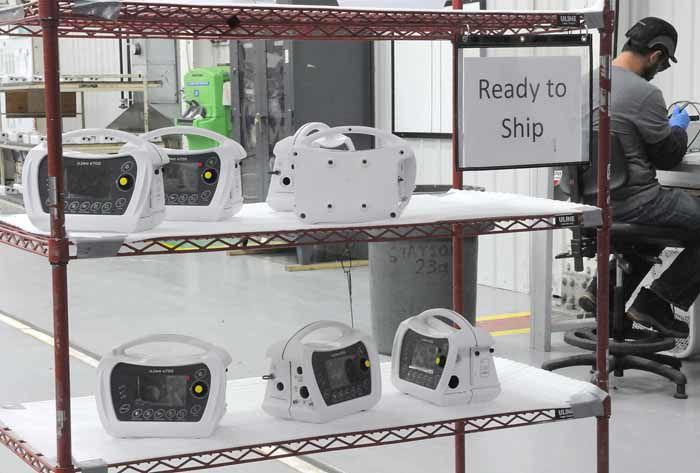Portable ventilators are rolling off the line at the Bombardier plant in Thunder Bay.
For now, about 45 employees returned to train for the production of the e-700 ventilators.
Work on the project will last up to four months for about 60 employees, who will produce 18,000 ventilators for Ontario. A portion of them will be sent to the United Kingdom and it is unknown if any will remain in Thunder Bay.
“We’ve had several employees that have asked to be part of this project because it’s exciting,” said Dave Black, Bombardier plant manager. “It’s exciting to be involved in something that’s going to potentially save lives.”
Dominic Pasqualino, president of Local 1075 of Unifor, said employees are really enthusiastic about being able to build the devices.
“As soon as people got wind that there was going to be a ventilator project, I got steady phone calls throughout the day,” he said. “People are calling from other lines saying, ‘Hey I want to get on this project because this is a piece of history.’”
From planes and mine sweepers to buses and rail cars, Pasqualino says this is the smallest item that they have ever built and the first thing they’ve produced for the health-care system.
“This is the most life-saving thing we have ever built — it’s the most important thing we built . . . it’s giving people back their very breath,” he said.
Preparation for the plant to convert to a ventilator assembly line involved creating a “clean room” for the ventilator line, cleaning and sanitizing everything, setting up safe workstations and painting the floor. Black says that all happened quickly.
Meanwhile, partnering company, 0-Two Medical Technologies, which produces ventilators in Brampton, Ont., saw its entire supply chain overturned with the onslaught of the COVID-19 pandemic.
“They went from having all kinds of parts and components to make ventilators, and that supply dried up completely,” said Black. “We needed to source parts and they were the supplier of parts — they did an amazing job to get them here to get things up and running.”
Once the parts arrived, they had to “qualify,” which means sending them out for testing to make sure that everything was satisfactory. While this happened, the room was set up, a risk assessment was done, health and safety equipment and measures were put in place and staff were trained on the assembly of the ventilators.
“I think it’s a fantastic day for Bombardier and for the community,” said Marcus Powlowski, MP for Thunder Bay-Rainy River, who is a doctor that helped to spearhead the project.
As the pandemic gripped Italy and other parts of the globe earlier this year, the world watched in horror as doctors had to choose who would and who wouldn’t get a life-saving ventilator because there was not enough of the units for every patient. Powlowski said the Canadian medical community and the government worried that this could happen in Canada.
“That was a big concern right from the beginning of this pandemic,” he said. “We didn’t want to get to that stage and this is only the second inning of a game that we don’t know how many innings there are.”
Having more ventilators for patients will be welcomed if a second wave of the coronavirus happens later this year.
“We are not gong to run out of ventilators now because we are mass producing them here in Canada,” said Powlowski. “Ideally we need to prevent people from getting that sick — but if they do get that sick with the virus, there is no alternative to a ventilator. I think every country in the world is going to want to have a stockpile of ventilators that they can use in case there is a surge in cases.”
(This story was originally published on May 30, 2020)


